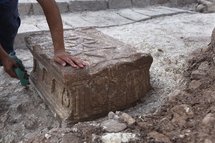
An archaeologist cleans the stone engraved with a seven-branched Menorah (candelabrum)
Archaeologists dug up the site in the early 1950s but identified it as the ruins of an ancient synagogue, a theory that was questioned in 2002 by a University of Chicago expert who identified the site as that of the Al-Sinnabra palace.
The latest excavations and research by the Hebrew University in Jerusalem confirmed the site was that of the palace where the Umayyad rulers would spend the winter months.
Among the caliphs who used the palace was Abd al-Malik, who initiated construction of the Dome of the Rock at the Al Aqsa Mosque compound which is Islam's third holiest site after Mecca and Medina in Saudi Arabia.
The Umayyads were an early Arab Muslim dynasty that ruled much of the Middle East and North Africa from 661 to 750 AD.
----------------------------------------------------------------------------
The latest excavations and research by the Hebrew University in Jerusalem confirmed the site was that of the palace where the Umayyad rulers would spend the winter months.
Among the caliphs who used the palace was Abd al-Malik, who initiated construction of the Dome of the Rock at the Al Aqsa Mosque compound which is Islam's third holiest site after Mecca and Medina in Saudi Arabia.
The Umayyads were an early Arab Muslim dynasty that ruled much of the Middle East and North Africa from 661 to 750 AD.
----------------------------------------------------------------------------









 Home
Home Politics
Politics









